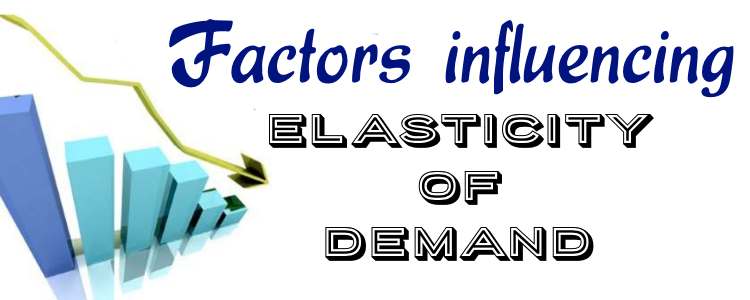Factors Influencing Elasticity of Demand
Table of Contents
- 1 Factors Influencing Elasticity of Demand
- 1.1 1. Nature of the Commodity Influence Elasticity of Demand
- 1.2 2. Uses of the Commodity influence Elasticity of Demand
- 1.3 3. Existence of Substitutes influence Elasticity of Demand
- 1.4 4. Postponement of Demand influence Elasticity of Demand
- 1.5 5. Amount of Money Spent influence Elasticity of Demand
- 1.6 6. Habits of Consumers influence Elasticity of Demand
- 1.7 7. Range of Prices of Commodities influence Elasticity of Demand
- 1.8 8. Time factor in Elasticity influence Elasticity of Demand
- 2 Conclusion
Factors Influencing Elasticity of Demand
There are many factors on which the elasticity of demand depends. These factors influence the elasticity of demand of a commodity either individually or cumulatively.

1. Nature of the Commodity Influence Elasticity of Demand
Why is it that demand for some goods is elastic while the demand for others is inelastic?
It mainly depends or the nature of the commodity and the degree of necessity. The elasticity of demand depends on whether a commodity is necessity, comfort or luxury. Normally the demand for necessaries of life such as rice, wheat, salt, etc., will be inelastic as these are essential for existence. So, everyone will demand a minimum quantity whatever be the price.
On the other hand the demand for comforts and luxuries may not have inelastic demand. When the prices of these fall, generally, more of the commodities will be demanded.
In this discussion we should remember that there is nothing inherent in the quality of a commodity to be called necessity or comfort or luxury. Even in necessities, commodities having substitutes will have elastic demand and commodities having no substitute will have inelastic demand.
Though wheat is a necessity as food for people, a rise in price may make the consumers go in for other cereals. This is not the case with salt which has no substitute. So, the demand for wheat may not be so inelastic as that of demand for salt.
Further in the case of luxuries, it should not be concluded that the elasticity of demand for luxuries will be always large. It depends on the type of luxury. For instance diamonds and articles of jewellery are luxuries used by richer classes. Any minor changes in prices will not affect its demand as these commodities are demanded only by richer people.
So much so, we should make it clear that the elasticity of demand may vary from commodity to commodity and also from group to group. What is luxury to one group may be comfort for another group and necessity for yet another group. Hence the elasticity on the basis of nature of commodity can be studied only on a comparative basis.
2. Uses of the Commodity influence Elasticity of Demand
If a commodity has only one use, a change in price will not affect the demand much and so it will have inelastic demand. If the commodity has a number of uses, change in price will affect the demand for the commodities in many uses.
When a commodity is put to various uses, it will have elastic demand. If the price of that commodity is increased, the commodity will be demanded only in essential uses, and in other uses, substitute materials will be utilized.
For instance a fall in price of coal may make everyone including the householders to demand coal and the demand will be elastic. A rise in price will result in the curtailment of the purchases and householders will shift to either firewood or oil. Here too, the statement that a commodity having several uses will have elastic demand has to be understood with a restrictive sense. For example coal will have elastic demand in houses but inelastic demand in Railways.
3. Existence of Substitutes influence Elasticity of Demand
Commodities having substitutes will have elastic demand and goods with no substitutes will have inelastic demand. When the price of a commodity rises, the people would shift their preference to substitute commodities and demand the substitutes with the hope that the price of substitutes will not rise.
Consequently the demand will fall heavily for the commodity for which the price has been increased. Suppose the commodity does not have substitute at all like salt, any change in price will not affect the demand and so the demand will be inelastic.
4. Postponement of Demand influence Elasticity of Demand
Another important factor affecting the demand in a bigger way is postponement of demand for a commodity. If the demand can be postponed, then the commodity will have elastic demand. If the demand cannot be postponed, it will have inelastic demand.
The demand for rice or medicines cannot be postponed while the demand for mangoes, oranges and apples can be postponed, if the prices of these rise. Hence demand for rice and medicines will be inelastic and the demand for the fruits will be elastic, that is, more will be purchased when the prices come down. Of course this factor, postponement of demand is only a corollary of the kind or nature of commodities already discussed.
In the case of necessities, the demand cannot be postponed and so demand becomes inelastic. In the case of commodities which are not necessities, demand can be postponed and so the demand becomes elastic.
5. Amount of Money Spent influence Elasticity of Demand
Elasticity of demand for a commodity also depends on the proportion of consumer’s money spent on the commodity. If the consumer spends only a little amount on the consumption of a particular commodity, the demand for that will be inelastic.
In the case of items like clothing or food, the consumer spends a large proportion of his income and therefore any increase in price will result in sizeably increasing his total expenditure. So to keep himself fairly within his means, the consumer will reduce the quantity purchased. The demand for these commodities will be elastic.
6. Habits of Consumers influence Elasticity of Demand
If the consumers are addicted to some habits and customs, then, the demand of the commodity will be inelastic. But if the rise in price persists for a long time, even addicts would try to reduce the demand either by resorting to some alternative substitutes or curbing the habit. Generally, commodities and drugs which are stimulants will have inelastic demand.
7. Range of Prices of Commodities influence Elasticity of Demand
Elasticity of demand for a commodity depends on the range of prices at which the commodity is sold in the market. At a very high range of prices, the demand will be inelastic; so also at a very low range of prices, the demand will be inelastic.
For example, the price of motor car is in the high range in which only the very rich can buy motor cars. At the price-range of Rs.80,000 any drop in price say by Rs.400 or Rs.500 nor any rise in price by that amount will not affect the demand for cars, since the demand comes from a limited group. At this level, the demand will be inelastic.
In the same way, if the price of a commodity is very low, whoever wants to buy, will be able to do so. Any small change in the price at the low level will not affect the demand. At low range prices, the demand will be inelastic, as also at high range of prices. Only in the middle range of prices demands tend to be elastic or moderate.
8. Time factor in Elasticity influence Elasticity of Demand
Time plays a vital role in the elasticity of demand for a commodity. Demand for commodity exists for a period of time, say, a day, week, month or year or several years. The supply and demand may also confine to a particular season.
Generally, demand for any commodity will be inelastic during the short period and it will be comparatively elastic during the long period. During the short period, the demand cannot be very responsive to the changes in prices because of the following reasons:—
Suppose the price of a commodity falls, the demand may not immediately rise because it will take sometime for consumers to come to know about the fall in price. Even if they come to know about the fall, the tendency will be to wait and watch for further fall in price. So the response will not be immediate.
Further, during the short time, the consumers may not be able to change their habit or pattern of expenditure. It will take sometime. Moreover there are many goods which are of a durable nature and so even if the prices fall, the demand may not be immediately forthcoming from the existing consumers.
For example, a fall in the price of fountain pens will not make us demand fountain pens unless the pen we are using becomes worn out and useless. So, in the short period whenever there is a fall in price, it may not lead to to increase in the quantity demanded suddenly.
In the same way, a rise in price will not immediately result in the reduction of the quantity demanded during the short time. The consumer will find it very difficult to make adjustments with substitute commodities. A rise in price of coal or firewood used as fuel will not result in the quantity demanded suddenly falling, even though the substitute like kerosene or gas may be cheap.
To make necessary arrangement for a substitute fuel, the consumer should make a capital expenditure like purchasing kerosene stove or gas oven so that the substitute fuel may be used. Initially the demand for coal and firewood will be inelastic. But after a long period, the consumers will make adjustments and have their own stoves, oil or gas, and the demand for coal and firewood will become elastic. So the elasticity of demand is greatly influenced by the time element.
Conclusion
In studying the elasticity of demand, we cannot decisively say which factor is influencing in a bigger way. The net result of demand being either elastic or inelastic will depend on the interplay of all these influences stated above.

